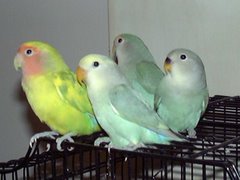Masked Lovebird- perfect breeders for you...
Masked lovebirds prefer to live in the grasslands of acacias and mimosa bushes. You can easily see a flock of forty birds at a point near the river banks, but they will avoid real highlands. They usually feed on grass and other seeds, as well as berries.
These lovebirds are always available from breeders or traders. Sexing these birds is really a daunting task. By observing the behavior, you can sex the birds to some extent. Male usually adopts the upright position and possess narrower eye ring. Males seldom reaches nest box. Females are larger and heavier. They usually line up the nest for laying eggs.
A single youngster kept in a cage soon becomes trusting. Its voice is less harsh than that of the peach-faced. Breeding has often proved sucessful, in a cage of 80 cm long. It is always wise to keep your birds as pairs, never more together, since otherwise fights break out.
Make sure that there is plentiful and constant supply of willow twigs because the birds use an enormous quantity of these in building their domed nests and the moisture that the twigs provide is important during incubation.
As for all lovebirds with white eye rings, incubation lasts twenty-one to twenty three days and the young remain on the nest for four to five weeks.
These small parrots can withstand a few degrees of frost, as long as they have boxes to retire to at night. Of course, newly-imported birds will need to be maintained at room temperature during their first winter here. They are somewhat delicate at first and need time to acclimatize themselves.










 Free Ads For Bloggers
Free Ads For Bloggers

